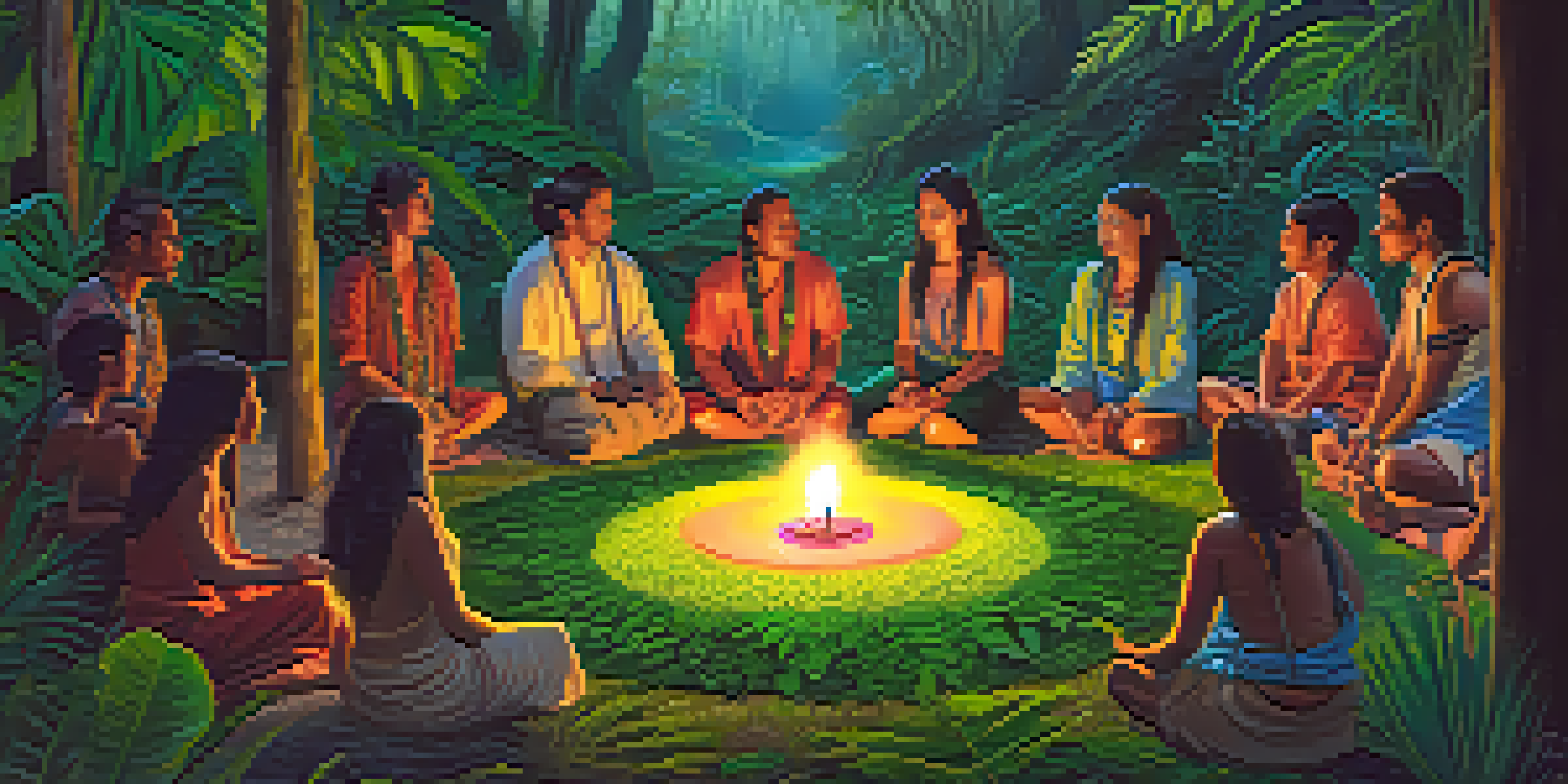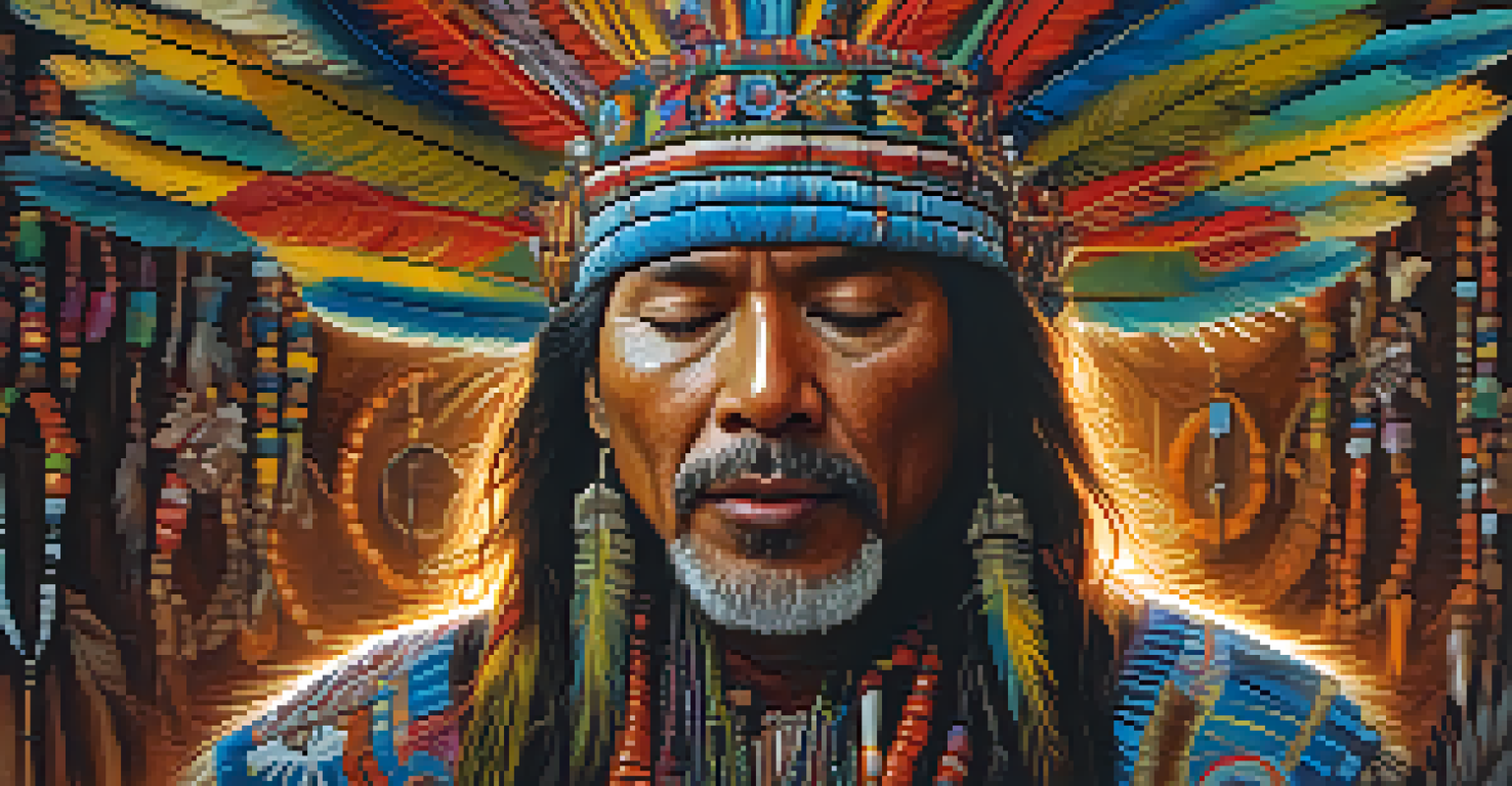The Therapeutic Benefits of Music in Ayahuasca Practices

Understanding Ayahuasca and Its Healing Properties
Ayahuasca is a traditional Amazonian brew made from two plants, known for its psychoactive properties. Users often seek it out for spiritual experiences or therapeutic healing. The combination of DMT in the brew and the MAOI effects leads to profound insights and emotional release.
Music can change the world because it can change people.
This powerful experience can be intense, both mentally and physically, which is where music comes into play. Traditionally, shamans use music to guide participants through their journeys, helping them cope with the emotional waves they may encounter. The right sounds can create a sense of safety and connection in what can be an overwhelming experience.
Understanding how music fits into this context is essential for both participants and facilitators. Music acts not just as a backdrop but as a tool for healing, providing a familiar anchor in an indescribable emotional landscape.
The Role of Traditional Icaros in Ayahuasca Ceremonies
Icaros are traditional songs sung by shamans during ayahuasca ceremonies. These songs are believed to carry spiritual power, guiding participants through their journeys. Each Icaro is unique, often tailored to the needs of the individual or the group, enhancing the therapeutic process.

The melodies and lyrics of Icaros can evoke deep emotional responses, helping participants to release trauma and connect with their inner selves. This connection can facilitate healing, as the music resonates with participants on a subconscious level. Essentially, Icaros serve as both a soundtrack and a spiritual guide.
Music as a Healing Tool
Music plays a crucial role in ayahuasca ceremonies, acting as a guide for emotional release and personal growth.
As participants immerse themselves in the experience, these songs can create a sense of unity and shared purpose. The communal aspect of singing and listening to Icaros fosters a deeper bond among participants, enhancing the overall therapeutic effect of the ceremony.
How Music Influences Emotional Release in Participants
Music has a profound impact on our emotions, often triggering memories or feelings we may not even be aware of. In the context of ayahuasca, certain musical elements can evoke feelings of joy, sadness, or even catharsis. This emotional release is a critical component of the healing process.
Where words fail, music speaks.
Participants often find that specific songs resonate with their personal struggles, allowing them to confront and process these emotions more effectively. The rhythm and melody can help to soften emotional barriers, making it easier to delve into difficult experiences. This is why the choice of music in ayahuasca ceremonies is so intentional.
By facilitating emotional release, music can lead to transformative experiences. The combination of ayahuasca's psychoactive effects and the emotional resonance of music can create a powerful environment for personal growth and healing.
Creating a Safe Space with Music During Ceremonies
One of the essential roles of music in ayahuasca ceremonies is to create a safe, nurturing environment. When participants feel secure, they are more likely to open up and explore their inner landscapes. Music can help establish this atmosphere, providing comfort and reassurance.
Shamans carefully select music that aligns with the energy of the group, using it to guide the emotional tone of the ceremony. This thoughtful curation helps participants navigate the highs and lows of their experiences. The right soundscape can make all the difference in how individuals process their journeys.
Icaros Enhance Emotional Connection
Traditional Icaros sung by shamans provide spiritual guidance and foster a sense of unity among participants during ceremonies.
Ultimately, a safe space supported by music can lead to deeper insights and more meaningful healing experiences. It’s this combination of emotional safety and the power of music that enhances the overall ayahuasca experience.
The Science Behind Music's Therapeutic Effects
Research shows that music can significantly affect our mental and emotional well-being. It triggers the release of neurotransmitters like dopamine, which play a crucial role in mood regulation. This scientific understanding helps explain why music is such a vital part of ayahuasca practices.
When combined with the psychoactive properties of ayahuasca, the effects of music can be even more pronounced. Studies suggest that music can enhance emotional processing and facilitate trauma resolution, making it an invaluable tool in therapeutic settings. This synergy between music and ayahuasca is where the magic often happens.
Understanding the science behind music's impact allows facilitators to craft more effective ceremonies. By integrating music thoughtfully, they can enhance the therapeutic outcomes for participants, making the experience not only memorable but transformative.
Integrating Music into Modern Ayahuasca Practices
As ayahuasca practices evolve, so too does the integration of music. Modern ceremonies may incorporate a variety of musical styles, from traditional Icaros to contemporary soundscapes. This blending of old and new can create unique experiences that resonate with a diverse audience.
Facilitators are increasingly recognizing the importance of curating an intentional soundtrack that supports participants' journeys. This can include ambient music, live instruments, or even recorded tracks that align with the ceremonial energy. The goal is to create a cohesive experience that enhances healing.
Modern Music Integration
The incorporation of diverse musical styles in contemporary ayahuasca practices enriches participants' healing experiences.
This evolution also reflects a broader understanding of how music can contribute to the therapeutic benefits of ayahuasca. By embracing different musical influences, modern practices can offer richer, more varied experiences for participants seeking healing and insight.
Personal Testimonials: Music's Impact on Healing Journeys
Many participants share powerful testimonials about how music influenced their ayahuasca experiences. For some, a particular song helped them confront deep-seated fears or traumas, leading to breakthrough realizations. These personal stories highlight the profound emotional connection that music can foster during ceremonies.
Others describe how the atmosphere created by music allowed them to feel more at ease, enabling them to delve deeper into their inner work. The sense of community and shared experience amplified by music often leads to lasting connections among participants. These testimonials serve as powerful reminders of music's role in the healing process.

By listening to these stories, we can appreciate the intricate relationship between music and healing. Each individual's journey underscores the importance of music as a facilitator of emotional release and personal growth within ayahuasca practices.